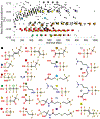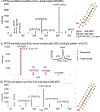FluoroMatch 2.0-making automated and comprehensive non-targeted PFAS annotation a reality
- PMID: 34014358
- PMCID: PMC10228292
- DOI: 10.1007/s00216-021-03392-7
FluoroMatch 2.0-making automated and comprehensive non-targeted PFAS annotation a reality
Abstract
Because of the pervasiveness, persistence, and toxicity of per- and polyfluoroalkyl substances (PFAS), there is growing concern over PFAS contamination, exposures, and health effects. The diversity of potential PFAS is astounding, with nearly 10,000 PFAS catalogued in databases to date (and growing). The ability to detect the thousands of known PFAS, and discover previously uncatalogued PFAS, is necessary to understand the scope of PFAS contamination and to identify appropriate remediation and regulatory solutions. Current non-targeted methods for PFAS analysis require manual curation and are time-consuming, prone to error, and not comprehensive. FluoroMatch Flow 2.0 is the first software to cover all steps of data processing for PFAS discovery in liquid chromatography-high-resolution tandem mass spectrometry samples. These steps include feature detection, feature blank filtering, exact mass matching to catalogued PFAS, mass defect filtering, homologous series detection, retention time pattern analysis, class-based MS/MS screening, fragment screening, and predicted MS/MS from SMILES structures. In addition, a comprehensive confidence level criterion is implemented to help users understand annotation certainty and integrate various layers of evidence to reduce overreporting. Applying the software to aqueous film forming foam analysis, we discovered over one thousand likely PFAS including previously unreported species. Furthermore, we were able to filter out 96% of features which were likely not PFAS. FluoroMatch Flow 2 increased coverage of likely PFAS by over tenfold compared to the previous release. This software will enable researchers to better characterize PFAS in the environment and in biological systems.
Keywords: Aqueous film forming foam; Liquid chromatography; Mass spectrometry; Non-targeted analysis; PFAS; Software.
© 2021. Springer-Verlag GmbH Germany, part of Springer Nature.
Figures







References
-
- EUR-Lex - 32017R1000 - EN - EUR-Lex. https://eur-lex.europa.eu/eli/reg/2017/1000/oj. Accessed 30 Oct 2020.
-
- Synthesis paper on per and polyfluorinated chemicals - OECD. https://www.oecd.org/chemicalsafety/risk-management/synthesis-paper-on-p.... Accessed 30 Oct 2020.
-
- Filipovic M, Woldegiorgis A, Norström K, Bibi M, Lindberg M, Österås A-H. Historical usage of aqueous film forming foam: a case study of the widespread distribution of perfluoroalkyl acids from a military airport to groundwater, lakes, soils and fish. Chemosphere. 2015;129:39–45. 10.1016/j.chemosphere.2014.09.005. - DOI - PubMed
-
- Hu XC, Andrews DQ, Lindstrom AB, Bruton TA, Schaider LA, Grandjean P, et al. Detection of poly- and perfluoroalkyl substances (PFASs) in U.S. drinking water linked to industrial sites, military fire training areas, and wastewater treatment plants. Environ Sci Technol Lett. 2016;3:344–50. 10.1021/acs.estlett.6b00260. - DOI - PMC - PubMed
MeSH terms
Substances
Grants and funding
LinkOut - more resources
Full Text Sources
Other Literature Sources

